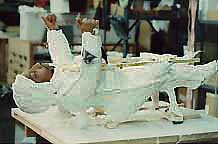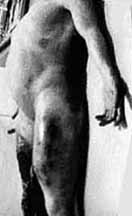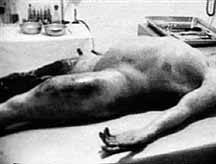A hypothetical example
Let's just suppose we were asked to do an
alien corpse for an autopsy scene in somebody's movie. Let's also
suppose our client doesn't want to do the "ultimate"
autopsy scene - they just want something that will be acceptable.
(Actually this example is hardly hypothetical so far. It's more
like a description of our entire careers.)
According to the script, the scene will include the following:
- This is a period piece intended to look like a 40's-era
documentary
- The body is supposed to resemble the commonly-accepted "alien"
description
- The body will be cut open and handled by the actors
- We want to show non-human internal organs
None of these requirements are especially difficult. We take
the job.
How do we proceed?
Once the check clears, we
have some important choices to make. There are two basic
techniques we could use to create the original form of our corpse
- sculpt the whole thing in clay, or do a body-cast. Since we're
doing a humanoid character, we might recommend a body cast for
this job. Once we have our body cast, we can adjust it in various
ways to make it more "alien." Even with our adjustments,
we'll still be stuck with a mostly human-looking corpse - but the
body-cast method is both easier and faster than sculpting the
entire alien from scratch.
The body-cast process is essentially this - we get a real live
human of the approximate size we need and cover them with
alginate - an organic product which goes on like a paste but
quickly solidifies into a rubbery semi-solid. (You may be
familiar with the stuff already - dentists use it to take tooth
casts.) We reinforce the alginate with layers of plaster
bandage.

An example of an actor being body-cast. Looks
fun, doesn't it?
When we remove the hardened bandages and alginate in two big
sections (front and back), we've got a "negative" of
our human's entire body. This will be the starting point for
creating our alien corpse. (Many FX companies store body-casts
from past projects - if we happened to have an existing
body-cast which fit our requirements we could skip this entire
step. Now that's economical!)
Now what?
Now, if we were really in a hurry we
might make our final alien from the body cast as is - but that
could lead to cosmetic problems later. The better technique is to
heat up a big batch of oil clay until it becomes liquid, pour the
clay into our mold and let it cool. (Pressing cold clay directly
into the mold is another option, too.) When we open the mold, we
have an instant "sculpture", which we can re-sculpt
until our body is exactly the way we want it.
This method does require us to make another mold
of the finished sculpture to create our final mold - our budget
goes up a little bit, but the improved results will make it
worth our while.
The resulting sculpture will have nice muscle definition and
all the subtle curves and shapes of a real body. Something like
this...

However, we made one mistake. (Actually we try not
to make this mistake - but this is hypothetical, remember?) We
cast our human standing up, because it was easier to get our
plaster bandages around them that way. We forgot our corpse
would eventually be seen on its back. Like this...

Unfortunately, our finished body won't have real muscles under
real skin - so it won't shift and react to gravity like a real
body would. This is a chubby little alien we're making - if it
were real the underside of the body would lie flatter against
the table. Someone looking very closely might also notice the
way the flesh appears to hang sideways, toward the toes, rather
than downward.
And because our body-cast subject was alive, the leg muscles
are visibly tensed rather than slack as a dead person's would
be.
Oh well, it's good enough. Let's move on.
Coming
up: Creepy Alien Bits!
Next page...